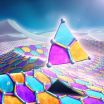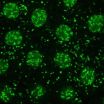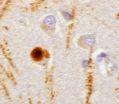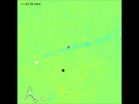(Press-News.org) This news release is available in German and Spanish.
Even computers are error-prone. The slightest disturbances may alter saved information and falsify the results of calculations. To overcome these problems, computers use specific routines to continuously detect and correct errors. This also holds true for a future quantum computer, which will require procedures for error correction as well: "Quantum phenomena are extremely fragile and error-prone. Errors can spread rapidly and severely disturb the computer," says Thomas Monz, member of Rainer Blatt's research group at the Institute for Experimental Physics at the University of Innsbruck. Together with Markus Müller and Miguel Angel Martin-Delgado from the Department for Theoretical Physics at the Complutense University in Madrid, the physicists in Innsbruck developed a new quantum error-correcting method and tested it experimentally. "A quantum bit is extremely complex and cannot be simply copied. Moreover, errors in the microscopic quantum world are more manifold and harder to correct than in conventional computers," underlines Monz. "To detect and correct general errors in a quantum computer, we need highly sophisticated so-called quantum error-correcting codes." The topological code used for this current experiment was proposed by Martin-Delgado's research group in Madrid. It arranges the qubits on a two-dimensional lattice, where they can interact with the neighboring particles.
A quantum bit encoded in seven ions
For the experiment at the University of Innsbruck the physicists confined seven calcium atoms in an ion trap, which allows them to cool these atoms to almost absolute zero temperature and precisely control them by laser beams. The researchers encoded the fragile quantum states of one logical qubit in entangled states of these particles. The quantum error-correcting code provided the program for this process. "Encoding the logical qubit in the seven physical qubits was a real experimental challenge," relates Daniel Nigg, a member of Rainer Blatt's research group. The physicists achieved this in three steps, where in each step complex sequences of laser pulses were used to create entanglement between four neighboring qubits. "For the first time we have been able to encode a single quantum bit by distributing its information over seven atoms in a controlled way," says an excited Markus Müller, who in 2011 moved from Innsbruck to the Complutense University in Madrid. "When we entangle atoms in this specific way, they provide enough information for subsequent error correction and possible computations."
Error-free operations
In another step the physicists tested the code's capability to detect and correct different types of errors. "We have demonstrated that in this type of quantum system we are able to independently detect and correct every possible error for each particle," says Daniel Nigg. "To do this we only need information about the correlations between the particles and don't have to perform measurements of the single particles," explains Daniel Nigg's colleague Esteban Martinez. In addition to reliably detecting single errors, the physicists were for the first time able to apply single or even repetitive operations on a logical encoded qubit. Once the obstacle of the complex encoding process is overcome, only simple single-qubit gate operations are necessary for each gate operation. "With this quantum code we can implement basic quantum operations and simultaneously correct all possible errors," explains Thomas Monz this crucial milestone on the route towards a reliable and fault tolerant quantum computer.
Basis for future innovations
This new approach developed by the Spanish and Austrian physicists constitutes a promising basis for future innovations. "This 7-ion system applied for encoding one logical quantum bit can be used as a building block for much larger quantum systems," says theoretical physicist Müller. "The bigger the lattice, the more robust it becomes. The result might be a quantum computer that could perform any number of operations without being impeded by errors." The current experiment not only opens new routes for technological innovations: "Here, completely new questions come up, for example which methods can be used in the first place to characterise such large logical quantum bits," says Rainer Blatt with a view into the future. "Moreover, we would also like to collaboratively develop the used quantum codes further to optimize them for even more extensive operations," adds Martin-Delgado.
INFORMATION:
The researchers are financially supported by the Spanish Ministry of Science, the Austrian Science Fund, the U.S. Government, the European Commission and the Federation of Austrian Industries Tyrol.
Publication: Quantum Computations on a Topologically Encoded Qubit. Daniel Nigg, Markus Müller, Esteban A. Martinez, Philipp Schindler, Markus Hennrich, Thomas Monz, Miguel Angel Martin-Delgado, and Rainer Blatt. Science 2014 DOI: 10.1126/science.1253742 (arXiv:1403.5426)
Quantum computation: Fragile yet error-free
2014-06-12
ELSE PRESS RELEASES FROM THIS DATE:
Movies with gory and disgusting scenes more likely to capture and engage audience
2014-06-12
Washington, DC (June 12, 2014) – We know it too well. We are watching a horror film and the antagonist is about to maim a character; we ball up, get ready for the shot and instead of turning away, we lean forward in the chair, then flinch and cover our eyes – Jason strikes again! But what is going on in our body that drives us to this reaction, and why do we engage in it so readily? Recent research published in the Journal of Communication found that people exposed to core disgusts (blood, guts, body products) showed higher levels of attention the more disgusting the content ...
NASA takes Tropical Cyclone Nanuak's temperature
2014-06-12
Tropical Cyclone Nanauk is holding its own for now as it moves through the Arabian Sea. NASA's Aqua satellite took its cloud top temperatures to determine its health.
In terms of infrared data viewing tropical cyclones, those with the coldest cloud top temperatures indicate that a storm is the most healthy, most robust and powerful. That's because thunderstorms that have strong uplift are pushed to the top of the troposphere where temperatures are bitter cold. Infrared data, such as that collected from the Atmospheric Infrared Sounder (AIRS) instrument that flies aboard ...
Findings point toward one of first therapies for Lou Gehrig's disease
2014-06-12
CORVALLIS, Ore. – Researchers have determined that a copper compound known for decades may form the basis for a therapy for amyotrophic lateral sclerosis (ALS), or Lou Gehrig's disease.
In a new study just published in the Journal of Neuroscience, scientists from Australia, the United States (Oregon), and the United Kingdom showed in laboratory animal tests that oral intake of this compound significantly extended the lifespan and improved the locomotor function of transgenic mice that are genetically engineered to develop this debilitating and terminal disease.
In humans, ...
Scientists identify Deepwater Horizon Oil on shore even years later, after most has degraded
2014-06-12
Years after the 2010 Deepwater Horizon Oil spill, oil continues to wash ashore as oil-soaked "sand patties," persists in salt marshes abutting the Gulf of Mexico, and questions remain about how much oil has been deposited on the seafloor. Scientists from Woods Hole Oceanographic Institution and Bigelow Laboratory for Ocean Sciences have developed a unique way to fingerprint oil, even after most of it has degraded, and to assess how it changes over time. Researchers refined methods typically used to identify the source of oil spills and adapted them for application on a ...
Anti-dsDNA, surface-expressed TLR4 and endosomal TLR9 cooperate to exacerbate lupus
2014-06-12
Systemic lupus erythematosus (SLE) is a complicated multifactorial autoimmune disease influenced by many genetic and environmental factors. The hallmark of systemic lupus erythematosus (SLE) is the presence of high levels of anti-double-stranded DNA autoantibody (anti-dsDNA) in sera. In addition, greater infection rates are found in SLE patients and higher morbidity and mortality usually come from bacterial infections. Deciphering interactions between the susceptibility genes and the environmental factors for lupus complex traits is challenging and has resulted in only ...
Protein anchors help keep embryonic development 'just right'
2014-06-12
The "Goldilocks effect" in fruit fly embryos may be more intricate than previously thought. It's been known that specific proteins, called histones, must exist within a certain range—if there are too few, a fruit fly's DNA is damaged; if there are too many, the cell dies. Now research out of the University of Rochester shows that different types of histone proteins also need to exist in specific proportions. The work further shows that cellular storage facilities keep over-produced histones in reserve until they are needed.
Associate Professor of Biology Michael Welte ...
Penn study describes new models for testing Parkinson's disease immune-based drugs
2014-06-12
PHILADELPHIA - Using powerful, newly developed cell culture and mouse models of sporadic Parkinson's disease (PD), a team of researchers from the Perelman School of Medicine at the University of Pennsylvania, has demonstrated that immunotherapy with specifically targeted antibodies may block the development and spread of PD pathology in the brain. By intercepting the distorted and misfolded alpha-synuclein (α-syn) proteins that enter and propagate in neurons, creating aggregates, the researchers prevented the development of pathology and also reversed some of the ...
Viral infections, including flu, could be inhibited by naturally occurring protein
2014-06-12
PITTSBURGH, June 12, 2014 – By boosting a protein that naturally exists in our cells, an international team of researchers led by the University of Pittsburgh Cancer Institute (UPCI), partner with UPMC CancerCenter, has found a potential way to enhance our ability to sense and inhibit viral infections.
The laboratory-based discovery, which could lead to more effective treatments for viruses ranging from hepatitis C to the flu, appears in the June 19 issue of the journal Immunity. The research is supported by the National Institutes of Health.
"Despite remarkable advances ...
African-Americans respond better to first-line diabetes drug than whites
2014-06-12
Washington, DC—African Americans taking the diabetes drug metformin saw greater improvements in their blood sugar control than white individuals who were prescribed the same medication, according to a new study published in the Endocrine Society's Journal of Clinical Endocrinology & Metabolism (JCEM).
An estimated 29 million Americans have diabetes. African Americans are twice as likely to be diagnosed with diabetes as whites and have a higher rate of complications such as kidney failure, according to the U.S. Department of Health and Human Services' Office of Minority ...
Brain power
2014-06-12
VIDEO:
Real-time movie of changes in total hemoglobin in the brain during stimulation. The initial blush of the brain is followed quickly by dilation (red) of arteries on the brain's surface....
Click here for more information.
New York, NY—June 12, 2014—In a new study published online in the Journal of the American Heart Association June 12, 2014, researchers at Columbia Engineering report that they have identified a new component of the biological mechanism that controls ...





